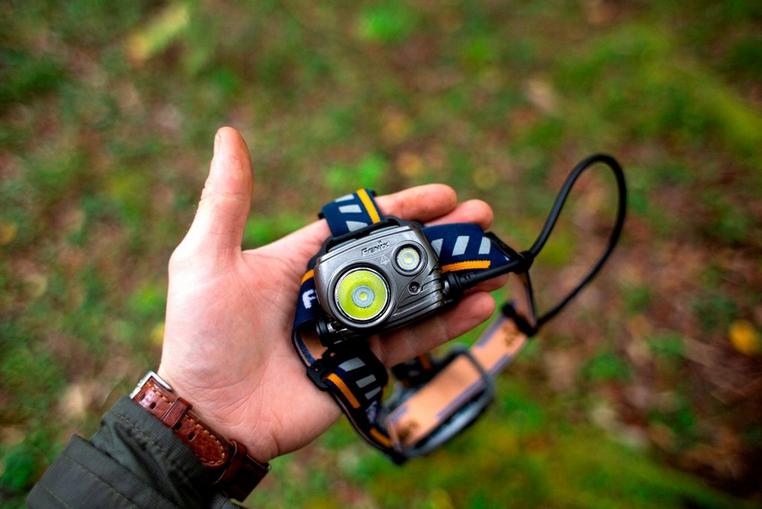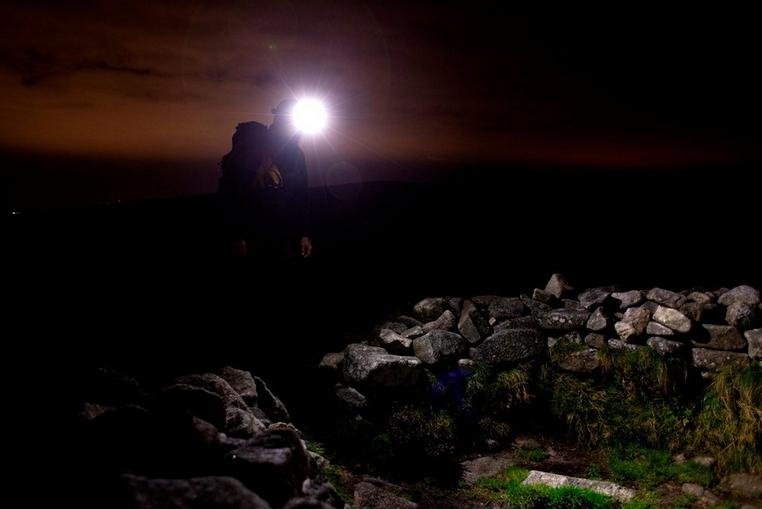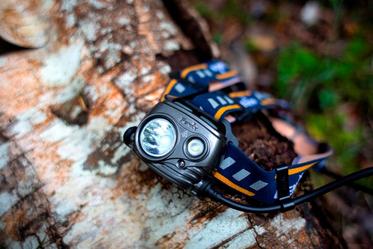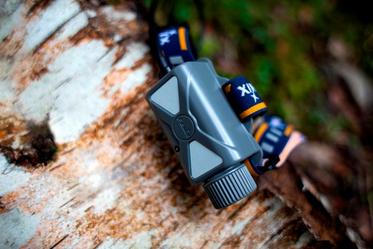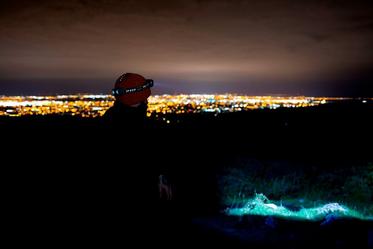Fenix HP25R | Expert Review by Padraig Croke
“It’s around here somewhere…” says my good friend and camping buddy Ciaran. We’ve been walking for about 40 mins in the darkness of Killarney National Park in Kerry. It’s 2am, wet and muddy, and we’re navigating our way to a hidden beach that hugs a lake in the middle of the park. It’s going to be our campsite for the night, and by day, it’s a sight to behold. By night however, it’s invisible. An empty, windy blackness that only gives an indication of its existence by the sound of waves on its shaley rocks. It’s hidden by a broadleaf woodland off the well-trodden path, and our task was to find the way into this woods. On the other side would be our beach.
These are the types of scenarios I’ve been finding myself in more and more lately, and with the winter months creeping in, it won’t be too long until the evening light fades before I get home from work. A good head torch is going to be invaluable! Enter the Fenix HP25R.
Light range
This head torch is a versatile piece of kit. Before owning it I never put too much thought into my torch option. If it’s comfortable on my head, and bright enough to see what’s in front of me, it’s good enough. It wasn’t until I switched to the Fenix that I realized what I was missing out on.
There are two buttons on the top of this torch, serving 9 different modes of lighting. The first button delivers a neutral white floodlight and uses a Cree XP-G2 R5 LED. Cycling the modes with this button will give you 4 levels of brightness, ranging from 4 to 350 lumens.
The other button delivers a powerful spotlight. Using a Cree XM-L2 U2 white light LED, it delivers 4 power levels ranging from 30 to 1000 lumens. It’s bright…very bright. At maximum power it will throw a beam of 187 meters! In this mode the body of the lamp does get warm, but the aluminium casing evenly distributes and dissipates heat quickly.
It also has 2 red light modes, steady beam and blinking mode. Red light is very useful when you are relying on your eyes' natural night vision, but you need to carry out tasks like reading your map and compass, or tracking animals. I have also used the red light blinking mode, on all night, to keep curious badgers the size of cocker spaniels away from my tarp… but that’s a story for another time. Honestly the HP25R is about as dynamic a torch as I could ever imagine needing for my outdoor and bushcraft needs.
Walking through the national park I decided it best to keep my head torch on flood light mode, and at maximum brightness its circumference was wide enough to help all four of us see our way. As we walked, we could see, bouncing back at us, the reflection of deer eyes. We stopped and I quickly switched to spotlight mode. The powerful beam illuminated the woods to either side of us as we watched the nocturnal activities of the deer. An amazing way to spend a Friday night. Returning to the flood light, we found our way into the woods, and after a bit of a hike, came upon our beach. The Fenix had helped us all the way there.
Performing tasks like this, quickly switching between modes on the torch is quite intuitive, and I very easily learned to control the light to my needs. The advantage of having two buttons for different light modes means you don’t have to memorize complex button controls to get to the desired setting. There’s no scrolling through your options with a single button, only to accidentally scroll past it and have to cycle through again to get back. It’s fast and efficient.
Construction and ergonomics
A good head torch should be a solid companion on your trips. The HP25R adds a serious amount of reliability and morale boosting for me, with its high power and versatile charging options (which I will get into later). However, where I feel this torch looses points is in its design aesthetics. I know there is no getting around the fact that professional level torch performance comes with a price in both weight and bulk. At 6.5oz (without the battery) it’s heavier than most head torches my fellow outdoorsmen carry. My last torch weighed 3.9oz, basically half the weight of the Fenix, although it was only a 350 lumen torch.
With the battery pack on the back of the headband as big as the torch on the front, and a thick wire connecting the two, It’s not the sleekest looking product. That being said, the separation of the battery housing from the torch itself, means that in colder weather you can protect the battery with your clothing or hat, while allowing the torch to do its job.
Having a relatively small head, I found the wire (which is designed to fit all sized heads and also hats and helmets) to be a little too long. It hangs clumsily to the side of the headband with 2 plastic clips. I haven’t had any issues with it yet, but going through thick terrain or underbrush I can see this wire getting caught and potentially pulling the torch from my head. But if you want a bright light, it requires a heavy duty battery for it to be able to perform, and this is simply something you have to consider when making your purchasing decisions. I just wish they had a smarter design solution to achieve this awesome performance.
The Little Torch that Could
The HP25R has a water resistance rating of IPX-6. The IPX system is the consumer product standard rating to indicate water resistance. IPX-6 requires a product to withstand heavy splashing and rain. It must not fail or show water seepage when exposed, but not when immersed in water.
I am not here to argue that certificate, but I will say that I think the HP25R is capable of more than this. I have actually lost this head torch while on a canoe trip with a party of 30 adventurers in Sweden. I was devastated at my loss, and had to borrow a friends spare head torch. However, a week later, after hearing me speak about this on the podcast, a listener who lives in the UK contacted me. He told me that while out fishing one morning on the the trip, he had found a head torch bobbing in the water! It turned out in fact to be my Fenix. It had survived a whole night floating in a lake. He returned it to me by post and now sits proudly amongst the rest of my kit once again.
Batteries and charging options
Although the HP25R is a USB charging head torch, it also has a range of other charging options available. I am a big proponent of not relying on head torches with specifically shaped or designed batteries that can only be charged through the torch. The simple reason for this is that, on longer trips, (lets say more than a week) you are very quickly going to run out of power if you are relying on a power bank to charge your electronics. Phones in particular rely on regular charging these days, and I carry a 20,000mAh bank just for this. So the last thing I want to have to do is decide whether I want to charge my phone or my head torch for the night ahead.
Thankfully this is not the case with this torch. As stated above, it can absolutely be charged via USB, useful to do before heading out on a trip. However, it can also be powered, either with an interchangeable 18650 rechargeable Li-ion battery or two CR123A batteries, which work perfectly (for those who work in colder climates will know) in temperatures below -40c.
At maximum spotlight setting you will get about 1.5 hours of light, and floodlight mode at max 2.5 hours. This is not a lot admittedly. The next level of brightness down will last you about 9 hours in floodlight mode, easily enough for a nights worth of adventure. Taking this into consideration, with a fully charged head torch, and a spare Li-ion battery with you, you can get bright performance for about 18 hours before you need to think about recharging. Alternatively, albeit expensively, you could simply carry a stash of CR123A batteries if that’s your preference. The point is that the versatility of these charging options makes the HP25R a very useful piece of kit for people who spend long periods before they have access to a power source.
Summary
In the time I have spent with this torch, I have found myself in a number of unexpected and unique situations where a decent light was essential. Having spent years working with a much less powerful head torch and being perfectly content, I was skeptical of the necessity to have anything brighter. That being said, a torch like this is going to have very obvious advantages to people like cave explorers, fishermen and hunters. I don’t (yet) participate in any of these, but if I did, I know what I would be using. For my adventures I’m hoping the HP25R lives up to its job. Somehow I think it will do the trick. I am guilty now of keeping my head torch on max brightness, simply because I can. I just hope I’m not spoiling my expectations for the next one.
Padraig Croke
Padraig Croke is the host of the outdoors podcast Trial by Fire, which ran from 2018-2023. A graphic designer and photographer by day, as well as an avid outdoorsman and bushcraft enthusiast, when he's not writing for us he's usually out in the field making film or taking photographs.

You can find his work at www.padraig.me or by following him on instagram @padraigcroke
Thanks, Padraig, for this awesome review!
